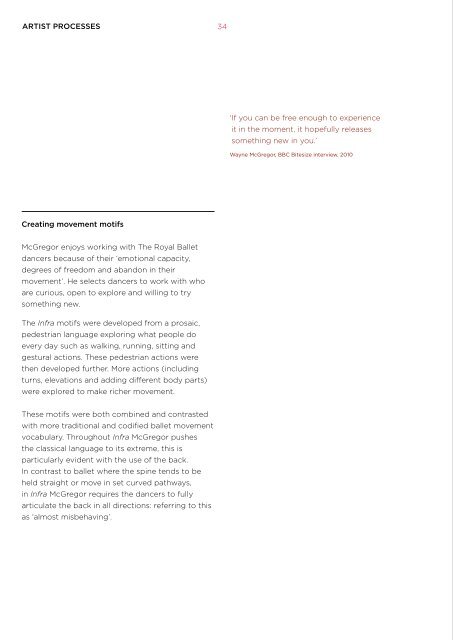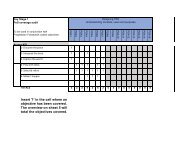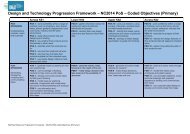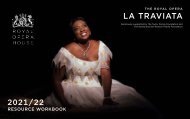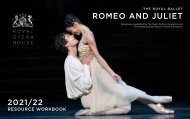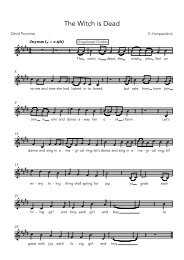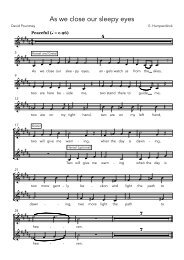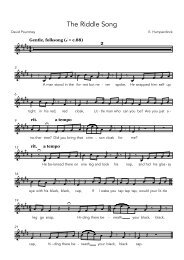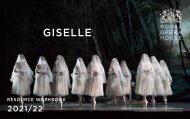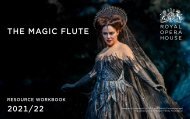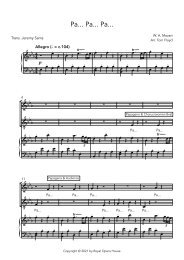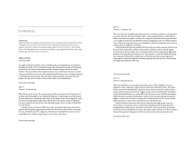Infra GCSE Resource
Create successful ePaper yourself
Turn your PDF publications into a flip-book with our unique Google optimized e-Paper software.
ARTIST PROCESSES<br />
34<br />
Left: Lucy Carter<br />
Right: Moritz Junge<br />
‘If you can be free enough to experience<br />
it in the moment, it hopefully releases<br />
something new in you.’<br />
Wayne McGregor, BBC Bitesize interview, 2010<br />
Creating movement motifs<br />
McGregor enjoys working with The Royal Ballet<br />
dancers because of their ‘emotional capacity,<br />
degrees of freedom and abandon in their<br />
movement’. He selects dancers to work with who<br />
are curious, open to explore and willing to try<br />
something new.<br />
The <strong>Infra</strong> motifs were developed from a prosaic,<br />
pedestrian language exploring what people do<br />
every day such as walking, running, sitting and<br />
gestural actions. These pedestrian actions were<br />
then developed further. More actions (including<br />
turns, elevations and adding different body parts)<br />
were explored to make richer movement.<br />
These motifs were both combined and contrasted<br />
with more traditional and codified ballet movement<br />
vocabulary. Throughout <strong>Infra</strong> McGregor pushes<br />
the classical language to its extreme, this is<br />
particularly evident with the use of the back.<br />
In contrast to ballet where the spine tends to be<br />
held straight or move in set curved pathways,<br />
in <strong>Infra</strong> McGregor requires the dancers to fully<br />
articulate the back in all directions: referring to this<br />
as ‘almost misbehaving’.<br />
Stage 4<br />
Lighting design and costume design<br />
At the same time as working with the dancers, set<br />
and sound design, McGregor also thinks about the<br />
lighting and costume design for the work.<br />
Lighting designer Lucy Carter designed the lighting<br />
for all of Wayne McGregor’s previous works. He<br />
describes Carter as being very instinctive as a<br />
designer and as well as collecting resources and<br />
information to fuel her creative process. She often<br />
experiments in the theatre, trying out the lights<br />
with the dancers in real time. This then inspires and<br />
develops McGregor’s choreographic ideas further.<br />
McGregor has worked with costume designer<br />
Moritz Junge many times and praises his ability to<br />
work with a broad spectrum of styles. For <strong>Infra</strong> the<br />
costume design was influenced by Julian Opie’s<br />
digital people and the starting point for costume<br />
was ‘pedestrian’ clothes, particularly when dressing<br />
the crowd of people who walk across the stage<br />
during the highlight in section 7b. It is important<br />
that the costumes are designed to work with<br />
the dancers’ bodies, aiding their movement and<br />
showing off their extraordinary skills.<br />
Stage 5<br />
Solving the problem, putting the jigsaw together<br />
The rest of the creative process involves all<br />
collaborators working together, discussing and<br />
sharing ideas and developments, observing<br />
McGregor and the dancers in rehearsal, selecting<br />
and structuring material and eventually piecing<br />
together the puzzle, synthesizing information<br />
to create a unified piece that can be realised,<br />
rehearsed, refined and performed.


